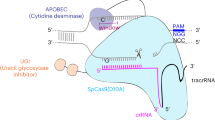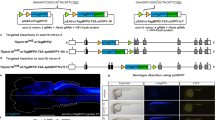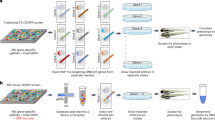Abstract
Zebrafish mutants have traditionally been obtained by using random mutagenesis or retroviral insertions, methods that cannot be targeted to a specific gene and require laborious gene mapping and sequencing. Recently, we and others have shown that customized zinc-finger nucleases (ZFNs) can introduce targeted frame-shift mutations with high efficiency, thereby enabling directed creation of zebrafish gene mutations. Here we describe a detailed protocol for constructing ZFN expression vectors, for generating and introducing ZFN-encoding RNAs into zebrafish embryos and for identifying ZFN-generated mutations in targeted genomic sites. All of our vectors and methods are compatible with previously described Zinc-Finger Consortium reagents for constructing engineered zinc-finger arrays. Using these methods, zebrafish founders carrying targeted mutations can be identified within 4 months.
This is a preview of subscription content, access via your institution
Access options
Subscribe to this journal
Receive 12 print issues and online access
$259.00 per year
only $21.58 per issue
Buy this article
- Purchase on SpringerLink
- Instant access to full article PDF
Prices may be subject to local taxes which are calculated during checkout






Similar content being viewed by others
References
Cathomen, T. & Joung, J.K. Zinc-finger nucleases: the next generation emerges. Mol. Ther. 16, 1200–1207 (2008).
Porteus, M.H. & Carroll, D. Gene targeting using zinc finger nucleases. Nat. Biotechnol. 23, 967–973 (2005).
Durai, S., Mani, M., Kandavelou, K., Wu, J., Porteus, M.H. & Chandrasegaran, S. Zinc finger nucleases: custom-designed molecular scissors for genome engineering of plant and mammalian cells. Nucleic Acids Res. 33, 5978–5990 (2005).
Carroll, D. Progress and prospects: zinc-finger nucleases as gene therapy agents. Gene Ther. 15, 1463–1468 (2008).
Wu, J., Kandavelou, K. & Chandrasegaran, S. Custom-designed zinc finger nucleases: what is next? Cell. Mol. Life Sci. 64, 2933–2944 (2007).
Camenisch, T.D., Brilliant, M.H. & Segal, D.J. Critical parameters for genome editing using zinc finger nucleases. Mini Rev. Med. Chem. 8, 669–676 (2008).
Kim, Y.G., Cha, J. & Chandrasegaran, S. Hybrid restriction enzymes: zinc finger fusions to Fok I cleavage domain. Proc. Natl. Acad. Sci. USA 93, 1156–1160 (1996).
Kim, Y.G., Shi, Y., Berg, J.M. & Chandrasegaran, S. Site-specific cleavage of DNA-RNA hybrids by zinc finger/FokI cleavage domain fusions. Gene 203, 43–49 (1997).
Maeder, M.L. et al. Rapid 'open-source' engineering of customized zinc-finger nucleases for highly efficient gene modification. Mol. Cell 31, 294–301 (2008).
Bibikova, M., Beumer, K., Trautman, J.K. & Carroll, D. Enhancing gene targeting with designed zinc finger nucleases. Science 300, 764 (2003).
Bibikova, M., Golic, M., Golic, K.G. & Carroll, D. Targeted chromosomal cleavage and mutagenesis in Drosophila using zinc-finger nucleases. Genetics 161, 1169–1175 (2002).
Santiago, Y. et al. Targeted gene knockout in mammalian cells by using engineered zinc-finger nucleases. Proc. Natl. Acad. Sci. USA 105, 5809–5814 (2008).
Miller, J.C. et al. An improved zinc-finger nuclease architecture for highly specific genome editing. Nat. Biotechnol. 25, 778–785 (2007).
Lombardo, A. et al. Gene editing in human stem cells using zinc finger nucleases and integrase-defective lentiviral vector delivery. Nat. Biotechnol. 25, 1298–1306 (2007).
Perez, E.E. et al. Establishment of HIV-1 resistance in CD4+ T cells by genome editing using zinc-finger nucleases. Nat. Biotechnol. 26, 808–816 (2008).
Doyon, Y. et al. Heritable targeted gene disruption in zebrafish using designed zinc-finger nucleases. Nat. Biotechnol. 26, 702–708 (2008).
Foley, J.E. et al. Rapid mutation of endogenous zebrafish genes using zinc finger nucleases made by Oligomerized Pool ENgineering (OPEN). PloS. ONE 4, e4348 (2009).
Meng, X., Noyes, M.B., Zhu, L.J., Lawson, N.D. & Wolfe, S.A. Targeted gene inactivation in zebrafish using engineered zinc-finger nucleases. Nat. Biotechnol. 26, 695–701 (2008).
Beumer, K.J. et al. Efficient gene targeting in Drosophila by direct embryo injection with zinc-finger nucleases. Proc. Natl. Acad. Sci. USA 105, 19821–19826 (2008).
Beumer, K., Bhattacharyya, G., Bibikova, M., Trautman, J.K. & Carroll, D. Efficient gene targeting in Drosophila with zinc-finger nucleases. Genetics 172, 2391–2403 (2006).
Morton, J., Davis, M.W., Jorgensen, E.M. & Carroll, D. Induction and repair of zinc-finger nuclease-targeted double-strand breaks in Caenorhabditis elegans somatic cells. Proc. Natl. Acad. Sci. USA 103, 16370–16375 (2006).
Townsend, J.A. et al. High-frequency modification of plant genes using engineered zinc-finger nucleases. Nature 459, 442–445 (2009).
Moehle, E.A. et al. Targeted gene addition into a specified location in the human genome using designed zinc finger nucleases. Proc. Natl. Acad. Sci. USA 104, 3055–3060 (2007).
Urnov, F.D. et al. Highly efficient endogenous human gene correction using designed zinc-finger nucleases. Nature 435, 646–651 (2005).
Shukla, V.K. et al. Precise genome modification in the crop species Zea mays using zinc-finger nucleases. Nature 459, 437–441 (2009).
Zou, J. et al. Gene targeting of a disease-related gene in human induced pluripotent stem and embryonic stem cells. Cell Stem Cell 5, 97–110 (2009).
Cai, C.Q. et al. Targeted transgene integration in plant cells using designed zinc finger nucleases. Plant Mol. Biol. 69, 699–709 (2009).
Hurt, J.A., Thibodeau, S.A., Hirsh, A.S., Pabo, C.O. & Joung, J.K. Highly specific zinc finger proteins obtained by directed domain shuffling and cell-based selection. Proc. Natl. Acad. Sci. USA 100, 12271–12276 (2003).
Cornu, T.I. et al. DNA-binding specificity is a major determinant of the activity and toxicity of zinc-finger nucleases. Mol. Ther. 16, 352–358 (2008).
Smith, J., Bibikova, M., Whitby, F.G., Reddy, A.R., Chandrasegaran, S. & Carroll, D. Requirements for double-strand cleavage by chimeric restriction enzymes with zinc finger DNA-recognition domains. Nucleic Acids Res. 28, 3361–3369 (2000).
Mani, M., Smith, J., Kandavelou, K., Berg, J.M. & Chandrasegaran, S. Binding of two zinc finger nuclease monomers to two specific sites is required for effective double-strand DNA cleavage. Biochem. Biophys. Res. Commun. 334, 1191–1197 (2005).
Beerli, R.R. & Barbas III, C.F. Engineering polydactyl zinc-finger transcription factors. Nat. Biotechnol. 20, 135–141 (2002).
Segal, D.J. The use of zinc finger peptides to study the role of specific factor binding sites in the chromatin environment. Methods 26, 76–83 (2002).
Liu, Q., Xia, Z., Zhong, X. & Case, C.C. Validated zinc finger protein designs for all 16 GNN DNA triplet targets. J. Biol. Chem. 277, 3850–3856 (2002).
Bae, K.H. et al. Human zinc fingers as building blocks in the construction of artificial transcription factors. Nat. Biotechnol. 21, 275–280 (2003).
Kim, H.J., Lee, H.J., Kim, H., Cho, S.W. & Kim, J.S. Targeted genome editing in human cells with zinc finger nucleases constructed via modular assembly. Genome Res. 19, 1279–1288 (2009).
Ramirez, C.L. et al. Unexpected failure rates for modular assembly of engineered zinc fingers. Nat. Methods 5, 374–375 (2008).
Maeder, M.L., Thibodeau-Beganny, S., Sander, J.D., Voytas, D.F. & Joung, J.K. An 'open-source' protocol for making customized zinc finger arrays. Nat. Protoc. 4, 1471–1501 (2009).
Carroll, D., Morton, J.J., Beumer, K.J. & Segal, D.J. Design, construction and in vitro testing of zinc finger nucleases. Nat. Protoc. 1, 1329–1341 (2006).
Wright, D.A. et al. Standardized reagents and protocols for engineering zinc finger nucleases by modular assembly. Nat. Protoc. 1, 1637–1652 (2006).
Sander, J.D., Zaback, P., Joung, J.K., Voytas, D.F. & Dobbs, D. Zinc finger targeter (ZiFiT): an engineered zinc finger/target site design tool. Nucleic Acids Res. 35, W599–W605 (2007).
Szczepek, M., Brondani, V., Buchel, J., Serrano, L., Segal, D.J. & Cathomen, T. Structure-based redesign of the dimerization interface reduces the toxicity of zinc-finger nucleases. Nat. Biotechnol. 25, 786–793 (2007).
Rembold, M., Lahiri, K., Foulkes, N.S. & Wittbrodt, J. Transgenesis in fish: efficient selection of transgenic fish by co-injection with a fluorescent reporter construct. Nat. Protoc. 1, 1133–1139 (2006).
Westerfield, M. The Zebrafish Book: A Guide for the Laboratory Use of Zebrafish (Danio Rerio) (The University of Oregon Press, Eugene, Oregon, 2000).
Yuan, S. & Sun, Z. Microinjection of mRNA and morpholino antisense oligonucleotides in zebrafish embryos. J. Vis. Exp. published online, doi:10.3791/1113 (7 May 2009).
Acknowledgements
We thank Dr. A.J. Giraldez for valuable suggestions and D. Cotelle for technical help on the fluorescent PCR analysis, Drs. P. Schlueter and C. Sachidanandan for helpful suggestions on the manuscript. J.E.F., M.L.M. and J.K.J. are supported by the NIH (R01GM069906, R21RR024189, and R21HL091808) and the MGH Pathology Service. R.T.P. and J.-R.J.Y. are supported by the NIH (CA118498 and GM88040) and the Ned Sahin Fund. J.-R.J.Y. is also supported by the NIH (AG031300) and the Claflin Distinguished Scholar Award.
Author information
Authors and Affiliations
Contributions
J.P. provided the protocol for plasmid DNA isolation in a 96-well format. All the other authors contributed extensively to the protocol development and preparation of the manuscript.
Corresponding author
Ethics declarations
Competing interests
J.K.J. is an inventor on patent applications which describe the OPEN zinc finger engineering method. All other authors declare that they have no competing financial interests.
Rights and permissions
About this article
Cite this article
Foley, J., Maeder, M., Pearlberg, J. et al. Targeted mutagenesis in zebrafish using customized zinc-finger nucleases. Nat Protoc 4, 1855–1868 (2009). https://doi.org/10.1038/nprot.2009.209
Published:
Issue Date:
DOI: https://doi.org/10.1038/nprot.2009.209



